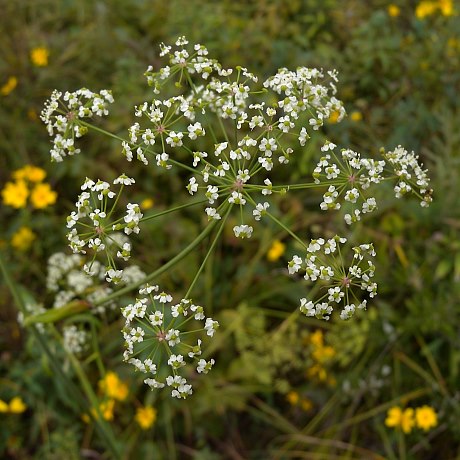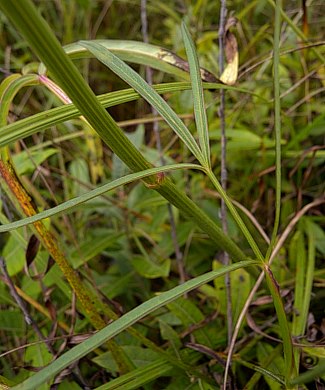Description: This herbaceous perennial wildflower is 2-5' tall and sparingly branched. The stems are medium green, terete, glabrous, and conspicuously veined. Alternate compound leaves occur along the stems that are odd-pinnate with 5-9 leaflets. The blades of these compound leaves are widely spreading to ascending; their outlined form extends to 1½' long and ¾' across. Generally, lower compound leaves are a little longer with wider leaflets than the upper ones. The compound leaves have stout petioles about 2-4" long; there is a sizeable sheath where each petiole joins the stem. The sessile leaflets are 1/8" to 1" across and 2½–4½" long; they are linear to elliptic-oblong in shape and smooth to sparingly dentate along their margins. If teeth are present, there are up to 7 widely spaced teeth on each side of a leaflet. The upper surfaces of the leaflets are medium green and hairless, while their lower surfaces are pale green and hairless.

The upper stems
terminate in compound umbels of small white flowers on long naked
peduncles. The compound umbels are slightly dome-shaped on the top.
Each compound umbel spans 3-5" across, consisting of about 12 umbellets
on slender stalks. Each umbellet has 10-20 flowers on short slender
pedicels. The floral stalks are light green and hairless. There are 0-3
small linear bracts at the base of each compound umbel, and 0-3 tiny
linear bractlets (bracteoles) at the base of each umbellet. Individual
flowers span about 1/8" (3 mm.) across, consisting of 5 white spreading
petals,
a short calyx, 5 stamens with white anthers, and a central pistil. The
blooming period occurs from late summer to early fall and lasts about a
month. The flowers are replaced by small hairless fruits (schizocarps)
containing the seeds. Mature seeds are 4-6 mm. long, ovoid, and nearly
flat on one side. The root system consists of a cluster of thick fleshy
roots.
Cultivation:
The preference is full sun, wet to moist conditions, and soil
containing loam, silt, or sand. There are few problems with pests and
disease. Temporary flooding is tolerated.

Range & Habitat:
The native Cowbane is occasional in the northern half of Illinois,
while in the
southern half of the state it is uncommon or absent (see Distribution
Map). Habitats include openings in floodplain forests, wet
sand prairies, sandy and non-sandy marshes, sandy and non-sandy swamps,
fens and seeps, and low areas along springs. Cowbane is found in higher
quality wetlands where much of the original native flora is still
intact.
Faunal Associations:
The flowers are cross-pollinated primarily by many different kinds of
wasps, flies, and beetles, which seek primarily nectar from the flowers
(see Robertson, 1929). Some small short-tongued bees also visit the
flowers (primarily Halictid and Masked bees) to suck nectar or collect
pollen. Both the foliage and the fleshy roots are highly toxic to
mammalian herbivores, therefore they are usually avoided as a source of
food. Cattle have been seriously poisoned by eating this plant.
Photographic Location:
A wet sand prairie at the Iroquois County Conservation Area in Illinois.
Comments:
Cowbane is another wetland species in the Carrot family that is toxic
and should not be eaten. It resembles many other species in this family
by its compound umbels of small white flowers and compound leaves.
These species are distinguished from each other primarily by the
structure and appearance of their compound leaves and leaflets, the
presence or absence of floral bracts, and the shape of their seeds.
Cowbane differs from other similar species in Illinois by the following
combination of features: 1) its compound leaves are simple-pinnate,
usually with 5-9 leaflets, and 2) its leaflets are either toothless or
sparingly dentate with up to 7 widely spaced teeth on each side of a
leaflet. Other similar species have double-pinnate leaves, or their
simple pinnate leaves tend to have more leaflets, or their leaflets
have more abundant serrated teeth that are closely spaced together.
Cowbane's leaflets are unusually variable in their width across
different populations. Plants with narrow linear leaflets (4 mm. across
or less) have been described as var. ambigua.